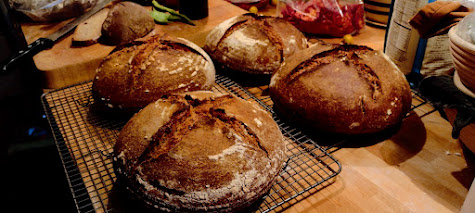Stereo Scope Images
I installed two 3# packages from Seattle (Urban Beekeeper I think) last weekend, and four 4# packages today (from Snohomish Bees), and I think that puts the total at 22 hives, but really- I think there are two or three that still won't make it, and maybe even a few others that are weak and might go. I will do some splits from the stronger "survivor" hives and so maybe I end up managing 20 again. It seems like about the right number and keeps me busy- even through winter. Reading Michael Bush's comment about learning how to manage 100 in the same time it used to take him to manage 4 is inspiring- but I sure don't see how yet (though he has a great list of suggestions).
I purchased another microscope- a stereo dissecting scope- which was an upgrade from the scope I used before (and gave to a botanist enthusiast contractor friend), and the new scope is infinitely interesting- so much to look at (as was the old one, but this allows me to connect a camera). Besides the camera, I also bought some directional lighting, and a mechanical stage, which all really add to the experience.
Below is an early sampling of images ( a few of many)...
Of course, there are bees to look at- lots of parts and pieces. There isn't a part on them that isn't interesting to look at.
I purchased another microscope- a stereo dissecting scope- which was an upgrade from the scope I used before (and gave to a botanist enthusiast contractor friend), and the new scope is infinitely interesting- so much to look at (as was the old one, but this allows me to connect a camera). Besides the camera, I also bought some directional lighting, and a mechanical stage, which all really add to the experience.
Below is an early sampling of images ( a few of many)...
Of course, there are bees to look at- lots of parts and pieces. There isn't a part on them that isn't interesting to look at.
A zoom stereo microscope allows you to explore a creature close up, or further away. Here is looking closer at the tarsii of the bees foot.
I can also look into open comb, and get the lighting to angle in. Here is a freshly laid egg:
And flowers are always a great thing to look at, in respect to bees, to understand the parts and pieces of what it is they have to deal with. In particular, in Spring, to understand where the pollen is located and how it is dispersed, and also to find the nectaries (which I have not- I am not quite sure what I am looking for, but it seems like it would be obvious- where actually does all that nectar come from? I can't find it. ). Here is what i assume are the small stamens in a dandelion- two curls with small grains of pollen on them ( I assume that's what I am looking at):
And here are the bases of the ovaries, with their filaments, not yet fertilized but ready to blow away. Its buried in a flower- you don't really see them unless you dig into it:
There are plenty more- it seems like every small thing deserves a photograph or drawing, its always such a surprise- but the best experience, and the clearest, is to actually see it directly through the scope. For one- its stereo- so everything is much more "there"- and a photo loses details and subtleties. But its great fun- and combined with a compound scope- a great way to learn how to identify and find some bee diseases and issues. I have both types of scopes, and love it- but have much to learn.







Comments
Post a Comment